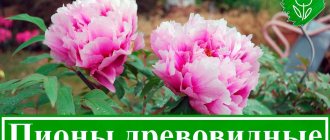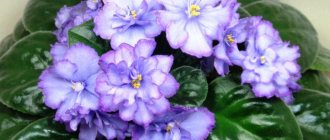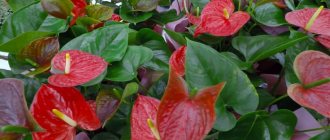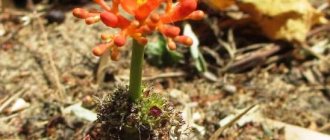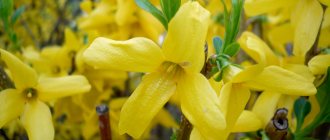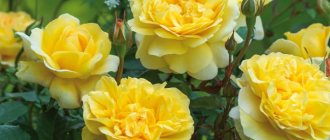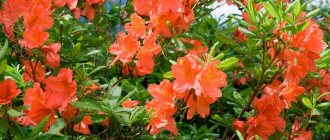- October 13, 2019
- Flowers
- Lyudmila Antonova
Evading peony (Paeonia anomala) is a perennial herbaceous plant of the Peony family. Another name is Maryin root or Maryin grass. The plant was first bred in the 18th century.
After its appearance, the plant could be found exclusively in botanical gardens. Currently, the Maryin root flower is actively used in the field of medicine and cosmetology. It is distinguished by its resistance to adverse conditions.
In this article we will study in detail how to plant the Maryin root flower and the care that the plant needs, and also consider the signs and properties of the plant.
Botanical description of the plant
When starting a conversation about Maryin root, planting and caring for the plant, we should talk about the botanical characteristics of the flower. This is necessary in order to have a complete understanding of the flower and understand what conditions it will need for optimal growth and development.
To make a botanical description, you should carefully look at the photo of the Maryina root flower.
This is a large plant, the length of its stems can reach one meter. The root system of the Maryin root flower consists of a massive tuberous rhizome with numerous fleshy brown adventitious roots. The inside of the root is light and has a specific smell. Sometimes the root of an adult plant weighs 5-6 kg, as it tends to store nutrients and moisture. Peony root is valued in the medical field.
Looking at the photo of the Maryina root, we can conclude that the stems of the plant are hard, thick, erect, single-flowered, and have leathery scales at the base. The leaves are compound, alternately arranged, large (up to 30 cm in length, 2.5 cm in width), with petioles. By autumn they change color from green to dark red.
The Maryin root flower is single, large, can reach 14 cm in diameter, and has a double perianth. The corolla consists of five purple-pink petals. The number of pestles is usually from 2 to 5 pieces. Stamens are numerous. The calyx consists of five green leaves. Maryina grass begins to bloom early. During drought and heat, the flowering period is reduced.
In August, the formation of the fetus occurs. The fruits of the plant are multi-seeded star-shaped leaves, which, when ripe, open along the length of the ventral suture. The seeds have a slight shine and black color.
Description: varieties and varieties
There are quite a lot of varieties and varieties of peony.
It comes in the form of a herbaceous plant and shrub. It is also found in the form of a subshrub. In nature, on the territory of our country, marin root can be found in some places of the wooded strip of European territory and in Siberia. It settles on taiga edges in forests, meadows and along floodplains, in mountainous areas. For a long time, this type of peony has been used to decorate gardens. In the photo you can see how great it looks, especially in bloom. Maryin root is excellent for open ground, withstands even the harshest winters, and is very easy to grow and propagate.
Maryin root - a type of peony
When grown in garden plots, this peony variety reaches a height of 1 m. Under favorable conditions, it can sometimes be larger in size. It grows as a bush with several erect branches. Each branch has several complex and large-sized leaves, which reach a length and width of about 30 cm. It blooms profusely, for about two weeks. Flowering time occurs from late spring to June. The flowers are large, about 15 cm in diameter, sometimes larger. The color is crimson or pink-purple. The root system of the plant is well developed.
Tales of Peony
Maryina grass has been known since ancient times. Mention of it can be found in many legends. There is an interesting myth about the name of peony. In Ancient Greece there lived a talented doctor and his name was Paean. He skillfully treated both the Olympian gods and people. He did it so well and saved so many lives that Paean's teacher began to envy him. The teacher, obsessed with envy, decided to poison his student, but at the right moment the gods came to the rescue and turned Paean into a beautiful bush strewn with flowers. Since then, this bush has been called a peony, and it continues to help people in the fight against diseases and illnesses, and photos, care and planting of the Maryin Root flower are important sections of many botanical books.
Maryin root was also endowed with magical powers. It was believed that he could ward off poisonous snakes and evil spirits, and also heal the possessed. Where there is a flower, evil spirits do not dare to show themselves. Necklaces and amulets were made from it. It was believed that replanting and digging up a plant could only be done at night, otherwise you could lose your eyesight. Girls who dreamed of getting married believed that if you grow a peony bush in the garden, you will definitely meet your future husband. And married couples were recommended to put peonies in the bedroom in order to rekindle their former passion.
7. Interesting facts, the meaning of peony
It is interesting that flower growers from various countries were fond of peonies - from Ancient China to Europe and Egypt. The Chinese were the first to develop new varieties - about 1,500 years ago, these beautiful plants were grown in the imperial gardens; mere mortals were strictly forbidden to keep this flower.
In Greece, the plant was considered a symbol of longevity, and beads were made from the dense spherical buds of the flower and it was believed that such jewelry could protect against evil spirits.
In Asian countries, peony flowers were cut and placed in a vase in the room of a girl who wanted to start a family - it was believed that the flower could attract the attention of a boy to the girl. In many regions, peony flowers are considered a symbol of wealth and love.
In many regions, peony flowers are considered a symbol of wealth and love.
All parts of plants are poisonous and can cause poisoning if ingested.
Peony flowers can decorate rooms in cut form for 7 - 10 days without losing their attractive appearance. Cutting is carried out in the morning or evening with a sharp, sterile knife. For cutting, shoots with buds that have just begun to bloom are selected - they will fully open in a vase with water.
The medicinal properties of peony are used in folk medicine and homeopathy - official science does not recognize the medicinal properties of plants. Back in ancient Rome, local healers noticed the calming effect of horse peony tincture - it was believed that it helped improve the quality of sleep.
It is believed that flowers appeared in Russia under Peter the Great - bushes with lush double flowers could be seen in the gardens of monasteries and on the plots of nobles. Plants with simple, non-double buds were used as medicinal plants. In European floriculture, the fashion for peonies began only in the 19th century - the milky-flowered peony was brought there from China.
There are several legends associated with the name of the plant. One of them talks about a very talented doctor - a young man named Paean, who studied with Aesculapius himself. The young doctor was very successful in his field and often cured the most difficult patients with the help of medicinal plants. The crown of his work was the healing of the god of the dead. Having learned about the student’s talent, Aesculapius wanted to destroy the peony, but the same god of the dead stood up for the student and turned him into a beautiful plant.
Spreading
Maryin root is a rare species with a certain distribution zone. Peony can be found in Russia (Siberia, the Urals, Perm Territory and the Komi Republic), China, Mongolia and Kazakhstan. The Mongols call it “purple peony”, the inhabitants of the Middle Kingdom call it “Xinjiang Peony”. In some areas, the plant is listed in the Red Book, and a photo of the Maryin Root flower is presented in botanical museums for clarity. After all, everyone needs to know what a rare plant looks like in order not to pick a flower while walking through the forest.
Maryin root: planting and care during vegetative propagation
The process of vegetative propagation is carried out by dividing the rhizome of the plant. It is necessary to divide it so that each part contains roots and buds. Cuts on the divided parts should be treated with charcoal powder and air dried. After this, the blanks are placed in recesses 50 cm deep, filled with a mixture of garden soil, sand and black soil with the addition of potassium salts and superphosphates. The empty space is filled with fertilized soil and moistened abundantly. For healthy growth, Maryina root needs space, so there should be a distance of more than 70 cm between plants.
As a rule, it is in the fall that the Maryina root is planted; care at this time should be special. It is necessary to ensure that the cuttings do not freeze. The plant quickly takes root and easily adapts to new conditions. It should be expected that the plant will not produce flowers in the first season.
5. Reproduction of peonies
There is a vegetative method of propagating peonies - dividing adult plants, cuttings using segments of rhizomes, and generative - growing a flower from seeds.
Seed propagation takes a fairly long period of time and requires patience. A similar method of propagation is used to develop new varieties of flowers. It is not worth growing peony from seeds in the garden - plants obtained in this way will not inherit the varietal attractiveness of the parent bushes.
5.1.Growing from seeds
For this method of propagation, you can use your own collected seeds.
In order to obtain high-quality planting material, the seed pods are allowed to fully ripen directly on the plants. The walls of such multi-leaflets will become thin and brownish, and the seeds inside will become glossy and dark brown.
Sowing of seeds is carried out immediately after ripening and collection - in August, on a previously dug area. The depth of seeding is 1 - 2 cm. The crops are watered, and in the autumn months they are covered with non-woven material until the first serious frost.
In early spring, the first shoots will appear in this place. In order to see the first flowering of peonies grown from seeds, you should be patient - it will occur only at the age of 4 - 5 years.
5.2.Division of bushes
Herbaceous peonies are easily propagated by division. Plants aged 5-6 years that have already bloomed for 1 or 2 seasons are suitable for such propagation. The bushes are dug up at the end of August - September, lightly shaken off the remaining soil.
The rhizomes are inspected for the presence of dead or rotten areas. Using sharp pruning shears or a garden knife, rotten and old roots are trimmed down to healthy tissue. The wounds resulting from such pruning are treated with charcoal powder or ash - this will help dry and disinfect such places.
Divide the rhizomes into several parts, so that in each part there are several strong roots with growth buds (in each division - 3 - 4 buds). Since mature bushes have a fairly dense middle, they can be separated using a wedge that is driven into the center of the plants with a hammer.
You should not make divisions that are too large or too small - the former have difficulty withstanding transplantation and take a long time to adapt to a new place, while the latter often die. Before planting, the cuttings should be treated with a clay mash mixed with copper sulfate and wood ash. This treatment will protect the roots from pathogenic microbes living in the soil. Next, the plants are planted in the garden and watered.
5.3. Reproduction by rhizome segments
Not all plants can reproduce in this way - mainly medicinal peony and American plants are propagated by cuttings of roots. When transplanting, the root system is cleared of soil and washed. The rhizomes are inspected and thick cuttings are cut off, each of which should have a renewal bud. Such segments can reach 8–10 cm in length.
The cuttings are sprinkled with charcoal at the ends and planted in the ground, and then watered. In the spring of next year, such cuttings will allow young plants to form only 1 - 2 leaves, in the second year their number will increase, and the first buds will appear only in 4 - 5 years.
Maryin root: propagation by seeds
In nature, Maryina grass reproduces by self-sowing. If you want to grow your own grass in the garden, you will have to work hard. Plants are not able to germinate quickly, which is due to their thick shell. The process, although not easy, is quite interesting.
So how to grow Maryin root from seeds? To begin with, the collected seeds must undergo pre-treatment:
- First stage. Place the seeds in soaked sand or on soaked cotton pads. The ambient temperature should be about +20-25 degrees Celsius. The duration of the first stage is 2 months. During the first stage of planting Maryina root, caring for the plant must be very careful. During this period, you need to monitor the seeds, maintain constant humidity and make sure that mold does not form. It will be most convenient to place the seeds on a tray, Petri dishes or ordinary plates.
- Second phase. After a couple of months, the seeds must be placed in a cool place with a temperature of +3-4 degrees Celsius. You can use the refrigerator. At this stage, it is worth moistening the Maryin root flower seeds once with a 0.1% solution of potassium permanganate. This procedure is carried out in order to avoid the formation of fungal infections. This period lasts a couple of months and should end with the emergence of seedlings.
- Third stage. After this, the seedlings are planted in pots, which are placed in a sunny but cool place. To obtain good seedlings, you can use phytolights. You also need to constantly feed and water young plants. It is recommended to use Gummi fertilizer three times during the growing period of seedlings. The first time was two weeks after landing, a month later - the second time, a month and a half later - the third time. This stage will last two to three months. When the seedlings are strong enough, the plant is planted in open ground.
Planting and caring for Maryina Root is a fairly simple task that even a novice gardener can handle. The plant is not picky; caring for this representative of the flora is not difficult.
Diseases and ways to combat them
Peony has good immunity to various diseases. The only problem that gardeners may encounter is gray rot, which occurs due to improper watering.
Preventive measures will help avoid this problem. To do this, pour a fungicidal solution under the bush of each plant. Repeat three times with an interval of two weeks.
Dangerous pests that can be found on a flower are:
- bronze;
- aphid;
- ants.
You can get rid of them with the help of insecticides and folk remedies. Use in accordance with the instructions, otherwise you can harm the physiological process of plants.
Choosing a landing site
An important role is played by the place where the Maryina root will be planted and cared for. The flower cannot be grown close to buildings and trees, since the plant prefers spacious and free areas. Also, before planting, you should make sure that there is no groundwater in the chosen location. If they are present, the plant will die. In areas where precipitation accumulates, the plant will also not be able to survive. Loose soil enriched with mineral and organic substances is perfect for peony.
Watering
It is not recommended to water Maryin root frequently, as waterlogging can cause the plant to rot. But this does not mean that you should ignore watering. It is advisable to irrigate the burnt grass once every 7 days. Each bush consumes about 10-20 liters of water. It is very important to water the plants in early spring, as flowers form at this time, and also in August, when buds begin to form. After irrigation, loosening the soil will have a beneficial effect on the plant. This is required for air exchange. After loosening the soil, it is recommended to get rid of weeds that interfere with the growth of the peony.
Peonies after flowering
After the flower fades, it needs care. These procedures are not complicated, which is why every gardener can carry them out.
Transfer
Preventive measures are carried out to prevent the occurrence of diseases. To do this, remove the root system and immediately deepen it into a new hole, but the roots should be located at a depth of 5 cm from the surface of the substrate.
Transplantation of the evasive peony is carried out in stages
Trimming
Bushes are pruned in the autumn, but before frost sets in, they are pruned so that their height does not exceed 10 cm.
You should know! All trimmings are necessarily burned under a certain pressure. In this case, it will be possible to avoid the appearance of pests.
Preparing for winter
The use of shelters is not required for an adult bush; it survives even the most severe climatic conditions. But young seedlings need to be protected, because in late autumn they are sprinkled with ash, and spruce branches are laid on top. Shrubs are pruned to prevent diseases.
Fertilizers
After planting, the Maryin root should not be left - care should include the introduction of fertilizers. It is better to fertilize young plants using the foliar method: it is recommended to irrigate the plant once a month with a solution of mineral fertilizer (Ideal is perfect) from a watering can. For a greater positive effect, add a soap-based solution. The best time for the procedure is the end of the day.
Adults are fed 3 times, every month. Fertilize the plants with a solution consisting of urea and water with the addition of organic elements. It is most effective to fertilize mature, strong plants at the root.
Each period of growth requires certain chemical elements: nitrogen - at the beginning of the growing season, during the formation of the inflorescence and active flowering - calcium, nitrogen and phosphorus, and when the plant forms buds - phosphorus and potassium are necessary.
Application in medicine
This representative of the flora is known for its rich content of organic and mineral components that have a beneficial effect on the human body. It is intensively used in medicine.
Medicines based on parts of the Maryina root have analgesic, anti-inflammatory, bactericidal, expectorant, sedative, and tonic properties, and also normalize blood pressure, increase immunity, reduce appetite, reduce aggression, improve sleep and generally have a positive effect on the central nervous system and mental health person.
Another property is stimulation of the production of endorphins or happiness hormones.
Maryina grass is also used to improve the health of the female body. During menopause, this tincture helps to cope with its consequences.
The plant helps fight anxiety, mood swings, depression, relaxes and calms. It is recommended to take peony-based tincture to regulate the monthly cycle and relieve menstrual pain. Also, the herb, in combination with other medications, fights such neoplasms in women as fibroids and cysts.
The use of tincture has a beneficial effect on men. It is a highly effective remedy for restoring potency.
Tinctures are perhaps the most popular medicine produced from Maryina root. They are usually made with water and alcohol. Also popular are decoctions prepared from the peony Maryina root. At the pharmacy you can buy a dry extract from this healing representative of the flora.
The underground and herbal parts of peony are used to make medicines. These parts are collected during the period of active flowering. Caring for and planting Maryina root for medicinal purposes is no different from planting a plant to decorate a garden.
Release form and composition
The drug is available in the form of a tincture, which is a transparent liquid of a light brown color with a methyl salicylate odor; sediment may form during storage (10, 15, 20 or 25 ml in dark glass bottles, sealed with stoppers, or dropper bottles, sealed with dropper stoppers / in imported brown glass bottles, sealed with pipette caps or regular caps / in polymer bottles or dropper bottles, sealed with dropper stoppers or polyethylene stoppers / in polyethylene terephthalate bottles, sealed with polymer screw caps; in a cardboard box 1 bottle and instructions for use of Peony evading tincture). Composition for 1 liter of tincture:
- active ingredients: peony herb - 50 g, rhizomes and roots of peony - 50 g;
- auxiliary components: 40% ethyl alcohol (in an amount sufficient to obtain 1 liter of tincture).
Depending on the manufacturer, other packaging options for the tincture are possible.
The raw material for the production of pharmacological drugs and the preparation of alternative products is the root of the plant. It contains a special glycoside, salicin, which is responsible for most of the medicinal properties of the herb. In addition to the indicated ingredient, peony evasive, marina root or heart berry contains the following chemicals:
- essential and fatty oils;
- alkaloids;
- methyl salicylate;
- flavonoids;
- tanning components;
- benzoic and salicylic acid;
- saponins;
- glycosides;
- Sahara;
- terpenoids;
- vitamin C;
- potassium;
- manganese;
- calcium;
- sitosterol;
- starch;
- resins;
- tannin and others.
Peony extract is a clear, brown liquid with a methyl salicylate odor. It consists of: the aerial part of the plant, its roots and ethyl alcohol (40%). The health benefits and harms of peony tincture are determined by the properties of the nutrients it contains:
essential oils – help regulate metabolism and digestion;
- tannins and organic acids – contribute to the normalization of vital processes in the body;
- antibiotics – help destroy bacteria and viruses;
- glycosides – improve the functioning of the cardiac system.
Popular traditional medicine recipes
To prepare a tincture with alcohol, you will need 60 g of pre-dried rhizome, which must be poured with a strong alcoholic drink (vodka or alcohol is often used). The root is infused for three weeks, enriching the liquid with useful substances, then it is filtered and taken for one month. This tincture helps get rid of anxiety, stress and insomnia, and also improves the general condition of the body. In ancient recipes they wrote about the property of the tincture to fight infertility.
To obtain a decoction for the treatment of gastrointestinal diseases, take 15 g of well-crushed parts of the root system of the zhgun-grass and pour boiled water. The solution is boiled over low heat for 9 minutes. When the mixture cools, it is filtered. It is advised to take the decoction 20 minutes before meals, three times a day.
To obtain a strengthening tea drink, you need to brew several petals of the Maryina root flower in one glass of boiled water. The resulting tea is taken 2 times a day. The drink stimulates the immune system; in cold weather, tea is taken to avoid colds.
Recipes for preparing medicines from evasive peony
Alcohol tincture can be purchased ready-made, or you can prepare it yourself. If you make it from the rhizomes of a plant, it will be most effective. To do this, you should collect peony roots in August and wash them thoroughly. Then grind in a glass or enamel container, pour in a strong solution of alcohol or vodka (it is better to take a stronger solution). Shake well several times, cover with a lid and put in a dark place for 10 days. After this, the infusion should be filtered and used according to the treatment method.
A decoction can be made from the rhizomes. You just need to boil them in water for 5 minutes. Then strain the solution - and the decoction is ready. It should be used for no more than two weeks, a teaspoon three times a day.
Is it poisonous?
Despite the fact that peony is so valued in medicine and many medicines are made from its parts, Maryin root is still a poisonous plant. There are certain contraindications to its use. Therefore, it is not recommended to take medicines made from the root without consulting a doctor as it may adversely affect your health. Be sure to consult a specialist before starting treatment.
Remember: evasive peony is a toxic plant. People with low blood pressure, kidney failure or individual intolerance should be wary of using such medications. People suffering from gastritis and high stomach acidity should not take the drug. To avoid side effects and allergies, it is forbidden to increase the dose and time of treatment. When the dosage is higher than normal, the central nervous system is suppressed. The use of medicines from Maryina root is also contraindicated for children and pregnant women.
Chemical composition
The plant has not been fully studied, but the main components are known. The composition of marina root includes the following substances:
- Fatty oil.
This component is necessary for hematopoiesis, strengthening the body's defenses, restoring normal hormonal levels and the biochemical composition of the blood. The substance also helps eliminate bad cholesterol. - Essential oil.
Gives the plant a characteristic aroma, has a positive effect on the intestines and stomach, enhancing their motility. The substance does not allow fermentation processes to develop and prevents rotting in the digestive system. The oil has a sedative effect on the body, promotes the development of an antibacterial effect, and when using products from evasive peony, gland secretion is stimulated. - Flavonoids.
Neutralizes the negative effects of microbes and promotes increased bile formation. They have an antioxidant effect and prevent the formation and growth of tumors. Strengthen blood vessels, cleanse the body of toxic substances, protect against allergens. - Tannins (the main component of the plant is tannin).
These substances neutralize the harm of pathogenic microbes, have an astringent effect and help the body fight inflammation. The damaged epithelium is restored by forming an albuminate film. Tannins reduce the secretion of hydrochloric acid when it is released excessively, and also coat the mucous membrane that lines the stomach from the inside. - Organic acids.
These substances speed up metabolism, strengthen bone tissue and joints, and restore normal acidity levels. Acids have an anti-inflammatory effect, and antioxidant activity is also manifested. - Minerals.
Maintaining a normal level of minerals in the body is required for the full functioning of the endocrine system and brain, and maintaining the healthy state of muscle tissue. When using products based on peony root, the body is saturated with iron, chromium, cobalt, aluminum, sulfur, copper, and potassium. - Alkaloids.
These substances have sedative properties, have a muscle relaxant and analgesic effect on the body, and help lower blood pressure. Alkaloids can restore any bleeding - both external and internal. - Glycosidic compounds (the main one in the plant is salicin).
Substances help remove mucus from the bronchi. Under their influence, the volume of urine increases and smooth muscles relax. In addition, blood vessels dilate and a sedative effect develops.
Use in cosmetology
Zhgun-grass contains many useful components, therefore it is used in cosmetology. The plant has been used in the beauty industry for many years.
The herb strengthens the hair roots, activates their growth, gives a healthy glow and helps reduce the secretion of oil and dandruff on the head. It is recommended to rub diluted infusions (not alcohol) into the scalp. It is also useful to add the infusion to water to rinse your hair.
Due to the fact that Maryin root contains essential oils, it is an excellent component of face creams. Its extract helps fight skin aging, and therefore is used to make creams and emulsions aimed at combating aging.
Infusions prepared from Maryina root are effective in the fight against acne and blackheads, since they contain salicylic acid. It is this that acts as a disinfectant on oily skin and dries it out. For some dermatological ailments it is used to heal wounds.
Contraindications to treatment with the plant
Like any other plant, peony has its drawbacks. There are a number of cases when the use of drugs based on it is undesirable. In what cases is marin root not suitable? The contraindications are as follows:
- low blood pressure (hypotension);
- allergic reactions (rashes) to the drug;
- pregnancy and lactation period;
- personal intolerance to components;
- alcoholism (if we are talking about the use of alcohol tincture);
- children's age up to 12 years.
In addition, as mentioned above, you should be extremely attentive to the preparation method and dosage when using. Any treatment can become poison if used incorrectly.
Use in cooking
In addition to its widespread use in cosmetology and medicine, its use in cooking can be added to the description of Maryina root. The underground part of the grass is edible. In wartime, it was used as food (boiled, fried and baked), and flour was also made from the root. Nowadays, Maryin root is most often added to dishes as a seasoning. In some regions of Kazakhstan, porridge is cooked from it. Tea prepared with the addition of this plant is also popular.
Having looked at the photo and description of the Maryina root, we can say that this is an amazing and beautiful flower that plays a significant role in different areas of human life.
